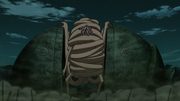mNo edit summary |
No edit summary |
||
| (32 intermediate revisions by 18 users not shown) | |||
| Line 1: | Line 1: | ||
{{Infobox/Jutsu |
{{Infobox/Jutsu |
||
| + | |ref=<ref name="d4">Fourth Databook, page 275</ref> |
||
| − | |image=Mountain Smash.png |
||
| + | |image=Earth Release- Sandwich Technique.png |
||
|kanji=土遁・山土の術 |
|kanji=土遁・山土の術 |
||
|unnamed jutsu=No |
|unnamed jutsu=No |
||
|romaji=Doton: Sando no Jutsu |
|romaji=Doton: Sando no Jutsu |
||
|literal english=Earth Release: Mountainous Earth Technique |
|literal english=Earth Release: Mountainous Earth Technique |
||
| − | | |
+ | |english tv=Earth Style: Mountain Jutsu |
| + | |game names=Earth Style: Sandwich Jutsu |
||
| ⚫ | |||
|jutsu classification=Ninjutsu, |
|jutsu classification=Ninjutsu, |
||
|jutsu type=Earth Release, |
|jutsu type=Earth Release, |
||
|jutsu class type=Offensive |
|jutsu class type=Offensive |
||
|jutsu range=Long |
|jutsu range=Long |
||
| − | |users=Kitsuchi |
+ | |users=Kitsuchi |
| + | |hand signs=Tiger, Ram, Rat, Slam hands on the ground |
||
|debut manga=537 |
|debut manga=537 |
||
| + | |debut anime=276 |
||
|debut shippuden=Yes |
|debut shippuden=Yes |
||
| + | |game debut=Naruto Shippūden: Ultimate Ninja Storm 3 |
||
| ⚫ | |||
| + | |jutsu media=Anime, Manga, Game |
||
}} |
}} |
||
| − | The user creates two enormous rock formations that close in on the opponent from |
+ | The user creates two enormous rock formations that close in on the opponent from opposing sides with tremendous force, smashing everything caught in between. Both of these formations are capable of dwarfing even the [[Demonic Statue of the Outer Path]] in size, and each half has the symbol of [[Iwagakure]] inscribed upon it. [[Kitsuchi]] stated that this was his strongest technique, standing as a testament to both this ability's destructive potential and its difficulty. |
| + | |||
| + | The anime shows that the technique can be used on a smaller scale against a group of few enemies.<ref name="ship320">''Naruto: Shippūden'' episode 320</ref> |
||
== Trivia == |
== Trivia == |
||
| − | * The word ''sando'' is a Japanese abbreviation for the English word ''sandwich |
+ | * The word ''sando'' is a Japanese abbreviation for the English word ''sandwich''. The technique is written with the kanji for "mountain" and "earth", both pronounced with their onyomi, while they would usually be pronounced with their kunyomi as "yamatsuchi". |
| + | * In the anime, the rock formations initially didn't have any details like the Iwagakure symbol etched onto it. They were added in a later episode. |
||
| + | |||
| + | == References == |
||
| + | <references/> |
||
| + | |||
| + | [[es:Elemento Tierra: Choque de Montañas]] |
||
Revision as of 00:22, 26 July 2015
The user creates two enormous rock formations that close in on the opponent from opposing sides with tremendous force, smashing everything caught in between. Both of these formations are capable of dwarfing even the Demonic Statue of the Outer Path in size, and each half has the symbol of Iwagakure inscribed upon it. Kitsuchi stated that this was his strongest technique, standing as a testament to both this ability's destructive potential and its difficulty.
The anime shows that the technique can be used on a smaller scale against a group of few enemies.[2]
Trivia
- The word sando is a Japanese abbreviation for the English word sandwich. The technique is written with the kanji for "mountain" and "earth", both pronounced with their onyomi, while they would usually be pronounced with their kunyomi as "yamatsuchi".
- In the anime, the rock formations initially didn't have any details like the Iwagakure symbol etched onto it. They were added in a later episode.

